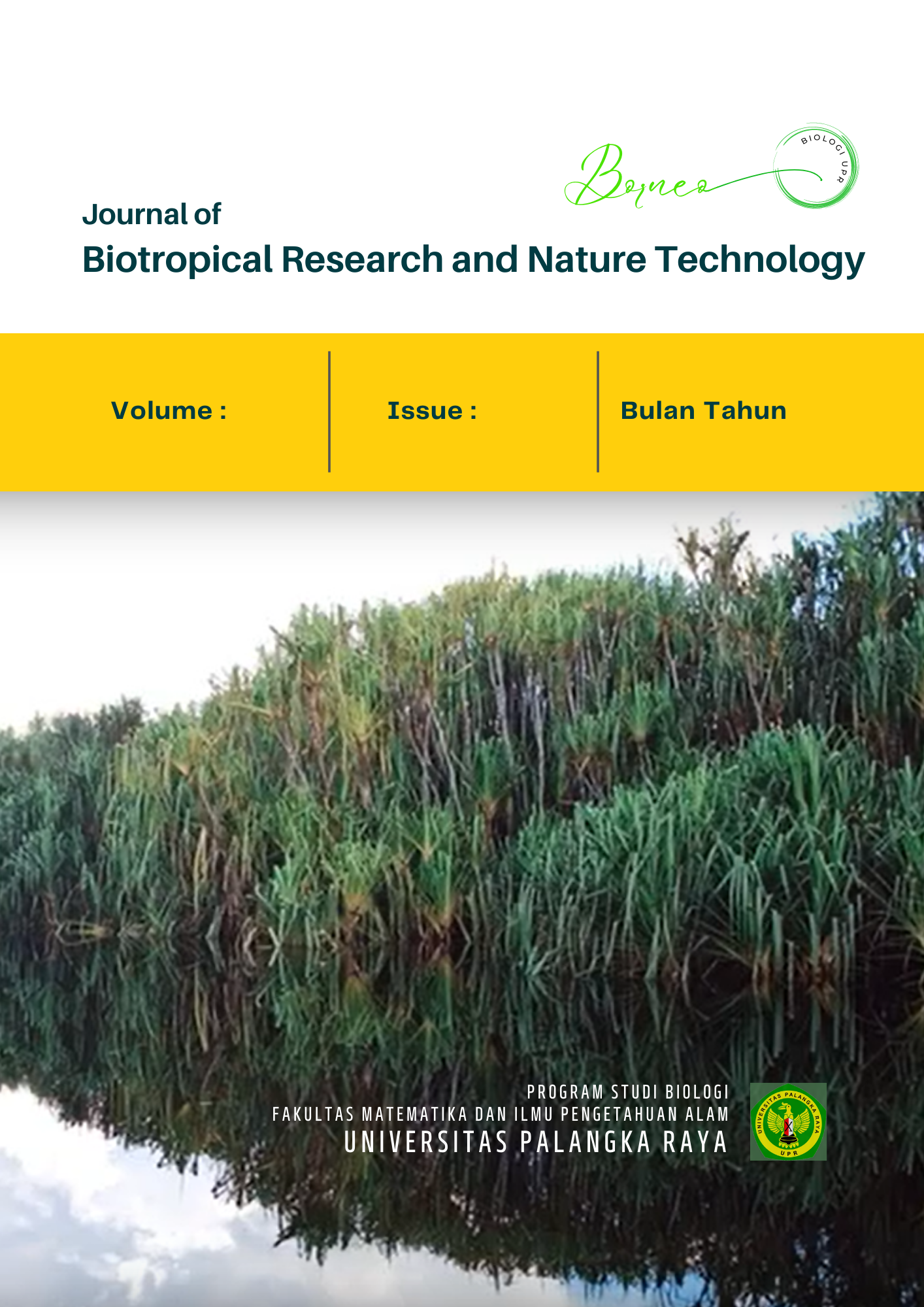Enhancing the Effectiveness of Trichogramma Wasps through Innovative Formulations
DOI:
https://doi.org/10.52850/borneo.v3i2.19603Keywords:
Biological Control; Efficiency; Formulation; TrichogrammaAbstract
The mass of Trichogramma wasp larvae, recognized as a vital agent for pest biocontrol in Iran, is produced primarily in the form of Trichocards. These bacteria are utilized for the biocontrol of key and significant pests, such as rice stem borers, corn stem borers, apple worms, and pomegranate fruit worms. However, the application of this formulation presents several drawbacks, including the difficulty of installing cards across fields and orchards, the destruction of larvae by predatory insects, and the sensitivity of larvae to dryness and high temperatures, which can impair the effectiveness of the method. Alternative formulations such as capsules, balls, and liquids have been introduced in various countries to address these application issues. These alternatives offer advantages such as increased durability of larvae under adverse conditions, increased lifespan and efficiency of wasps, reduced production costs, faster operational speed, and greater willingness among farmers and orchardists to adopt biological methods. Given that the method of supplying Trichogramma larvae has remained unchanged in its production stages over the past 30 years in Iran, a continuous dynamic growth trend in the application of Trichogramma wasps will undoubtedly require a reassessment of various supply stages and an improvement in the production process.
Downloads
References
A. Ivezić dan B. Trudić, “Parasitoids of the genus Trichogramma (Hymenoptera: Trichogrammatidae), natural enemies of European corn borer Ostrinia nubilalis (Hübner, 1796) (Lepidoptera: Crambidae),” J. Cent. Eur. Agric., vol. 22, no. 4, hlm. 787–797, 2021, doi: 10.5513/JCEA01/22.4.3247.
S. Morrone, C. Dimauro, F. Gambella, dan M. G. Cappai, “Industry 4.0 and Precision Livestock Farming (PLF): An up to Date Overview across Animal Productions,” Sensors, vol. 22, no. 12, hlm. 4319, Jun 2022, doi: 10.3390/s22124319.
S. M. Mahdavian, F. Askari, H. Kioumarsi, R. Naseri Harsini, H. Dehghanzadeh, dan B. Saboori, “Modeling the linkage between climate change, CH4 emissions, and land use with Iran’s livestock production: A food security perspective,” Nat. Resour. Forum, hlm. 1477-8947.12532, Jun 2024, doi: 10.1111/1477-8947.12532.
L. Kalavari, N. Nasiri, F. Ahmadian, dan H. Kioumarsi, “Enrichment of Doogh with Olive Leaf Extract and Investigation of Its Physicochemical, Microbial, and Sensory Properties during Storage at Room Temperature and Refrigerator,” J. Multidiscip. Appl. Nat. Sci., vol. 3, no. 1, hlm. 34–42, Agu 2022, doi: 10.47352/jmans.2774-3047.143.
A. Khakpour, N. A. Shadmehri, H. Amrulloh, dan H. Kioumarsi, “Antibacterial Effect of Juglans regia, Citrus sinensis, Vicia faba, and Urtica urens Extracts under In vitro Conditions,” Bioactivities, vol. 1, no. 2, hlm. 74–80, Okt 2023, doi: 10.47352/bioactivities.2963-654x.195.
A. Al-Riyami dan I. C. W. Hardy, “Conspicuous by their absence: extremely rare field parasitism by Trichogramma wasps imported to control pest butterflies in a pomegranate agro-ecosystem,” Biocontrol Sci. Technol., vol. 34, no. 1, hlm. 65–78, Jan 2024, doi: 10.1080/09583157.2023.2297163.
M. G. Solomon dkk., “Biocontrol of Pests of Apples and Pears in Northern and Central Europe - 3. Predators,” Biocontrol Sci. Technol., vol. 10, no. 2, hlm. 91–128, Apr 2000, doi: 10.1080/09583150029260.
Ch. Ulrichs dan I. Mewis, “Evaluation of the efficacy of Trichogramma evanescens Westwood (Hym., Trichogrammatidae) inundative releases for the control of Maruca vitrata F. (Lep., Pyralidae),” J. Appl. Entomol., vol. 128, no. 6, hlm. 426–431, Jul 2004, doi: 10.1111/j.1439-0418.2004.00867.x.
L.-S. Zang, S. Wang, F. Zhang, dan N. Desneux, “Biological Control with Trichogramma in China: History, Present Status, and Perspectives,” Annu. Rev. Entomol., vol. 66, no. 1, hlm. 463–484, Jan 2021, doi: 10.1146/annurev-ento-060120-091620.
“Peer Review #1 of ‘Penetrance of symbiont-mediated parthenogenesis is driven by reproductive rate in a parasitoid wasp (v0.1).’” doi: 10.7287/peerj.3505v0.1/reviews/1.
H. Xu dkk., “Supplementary sugars enhance the production efficiency and parasitism performance of the egg parasitoid Trichogramma dendrolimi (Hymenoptera: Trichogrammatidae),” J. Econ. Entomol., vol. 117, no. 5, hlm. 1729–1738, Okt 2024, doi: 10.1093/jee/toae168.
G. M. Gurr dan H. I. Nicol, “Effect of food on longevity of adults of Trichogramma carverae Oatman and Pinto and Trichogramma nr brassicae Bezdenko (Hymenoptera: Trichogrammatidae),” Aust. J. Entomol., vol. 39, no. 3, hlm. 185–187, Jul 2000, doi: 10.1046/j.1440-6055.2000.00159.x.
J. D. Cluever, C. W. Beiermann, N. C. Lawrence, dan J. D. Bradshaw, “Assessing the toxicity of selected pesticides to Trichogramma ostriniae (Hymenoptera: Trichogrammatidae) pupae as a first step in the development of a potential novel deployment programme,” Biocontrol Sci. Technol., vol. 33, no. 11, hlm. 1065–1084, Nov 2023, doi: 10.1080/09583157.2023.2275116.
R. M. Goulart, H. X. Volpe, A. M. Vacari, R. T. Thuler, dan S. A. De Bortoli, “Insecticide selectivity to two species of Trichogramma in three different hosts, as determined by IOBC/WPRS methodology,” Pest Manag. Sci., vol. 68, no. 2, hlm. 240–244, Feb 2012, doi: 10.1002/ps.2251.
J. Pizzol, B. Pintureau, O. Khoualdia, dan N. Desneux, “Temperature-dependent differences in biological traits between two strains of Trichogramma cacoeciae (Hymenoptera: Trichogrammatidae),” J. Pest Sci., vol. 83, no. 4, hlm. 447–452, Des 2010, doi: 10.1007/s10340-010-0327-0.
M. Askari Seyahooei, A. Mohammadi-Rad, S. Hesami, dan A. Bagheri, “Temperature and Exposure Time in Cold Storage Reshape Parasitic Performance of Habrobracon hebetor (Hymenoptera: Braconidae),” J. Econ. Entomol., vol. 111, no. 2, hlm. 564–569, Apr 2018, doi: 10.1093/jee/toy004.
W. T. Oehmichen dkk., “Temperature based differences in biological parameters of some potential species/strains of Trichogramma,” J. Biol. Control, vol. 31, no. 2, hlm. 82–89, Nov 2017, doi: 10.18311/jbc/2017/16338.
D. M. Firake dan M. A. Khan, “Alternating Temperatures Affect the Performance of Trichogramma Species,” J. Insect Sci., vol. 14, no. 41, hlm. 1–14, Mar 2014, doi: 10.1673/031.014.41.
S. Bhandari, K. R. Pandey, Y. R. Joshi, dan S. K. Lamichhane, “An overview of multifaceted role of Trichoderma spp. for sustainable agriculture,” Arch. Agric. Environ. Sci., vol. 6, no. 1, hlm. 72–79, Mar 2021, doi: 10.26832/24566632.2021.0601010.
J. Karimi dkk., “Analytical Approach to Opportunities and Obstacles of Iranian Biological Pest Control,” dalam Biological Control of Insect and Mite Pests in Iran, vol. 18, J. Karimi dan H. Madadi, Ed., dalam Progress in Biological Control, vol. 18. , Cham: Springer International Publishing, 2021, hlm. 601–621. doi: 10.1007/978-3-030-63990-7_17.
R. Tang, D. Babendreier, F. Zhang, M. Kang, K. Song, dan M.-L. Hou, “Assessment of Trichogramma japonicum and T. chilonis as Potential Biological Control Agents of Yellow Stem Borer in Rice,” Insects, vol. 8, no. 1, hlm. 19, Feb 2017, doi: 10.3390/insects8010019.
J. Gardner, M. P. Hoffmann, S. A. Pitcher, dan J. K. Harper, “Integrating insecticides and Trichogramma ostriniae to control European corn borer in sweet corn: Economic analysis,” Biol. Control, vol. 56, no. 1, hlm. 9–16, Jan 2011, doi: 10.1016/j.biocontrol.2010.08.010.
E. Vindas-Reyes, R. Chacón-Cerdas, dan W. Rivera-Méndez, “Trichoderma Production and Encapsulation Methods for Agricultural Applications,” AgriEngineering, vol. 6, no. 3, hlm. 2366–2384, Jul 2024, doi: 10.3390/agriengineering6030138.
Downloads
Published
How to Cite
Issue
Section
License
Copyright (c) 2025 Hamed Kioumarsi, Hanif Amrulloh, Seyed Reza Fani, Golbanoo Azizpoor

This work is licensed under a Creative Commons Attribution-ShareAlike 4.0 International License.
- Authors retain copyright and acknowledge that the Journal of Multidisciplinary Applied Natural Science is the first publisher, licensed under a Creative Commons Attribution-Share Alike 4.0 (CC BY-SA).
- Authors are able to enter into separate, additional contractual arrangements for the non-exclusive distribution of the journal's published version of the work (e.g., post it to an institutional repository or publish it in a book), with an acknowledgment of its initial publication in this journal.
- Authors are permitted and encouraged to post their work online (e.g., in institutional repositories or on their website) prior to and during the submission process, as it can lead to productive exchanges and earlier and greater citation of published work.








